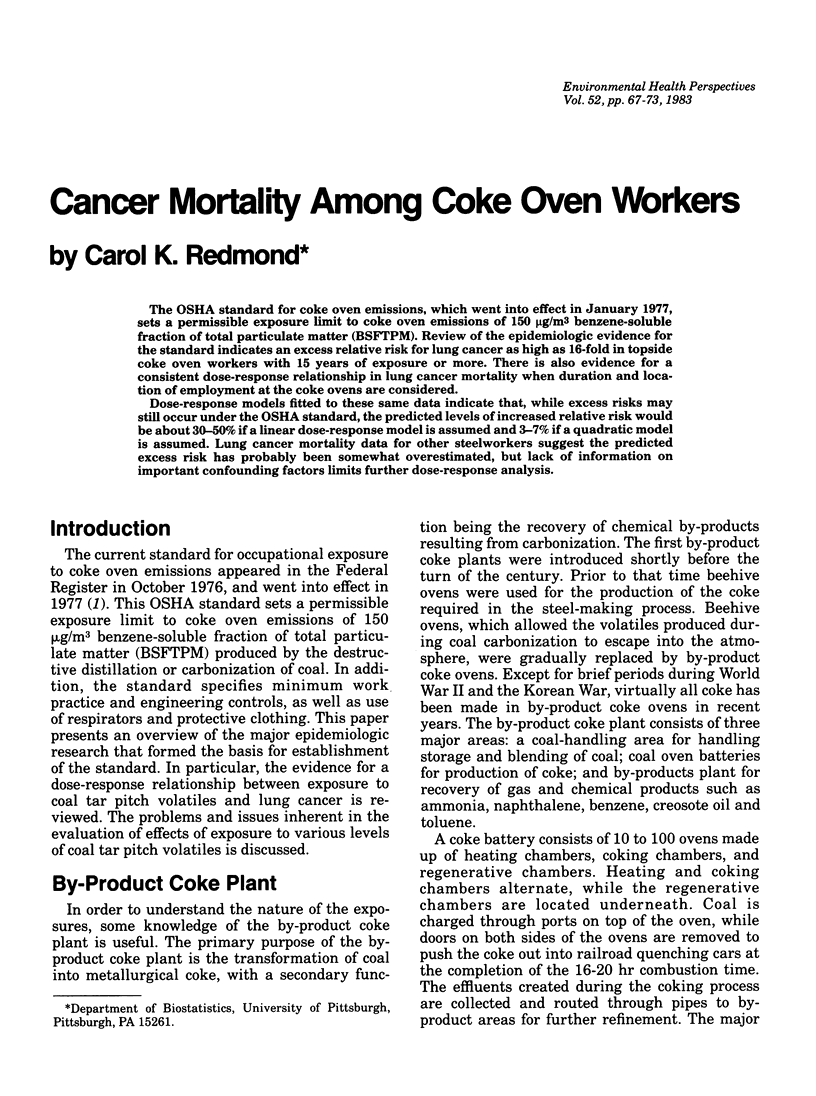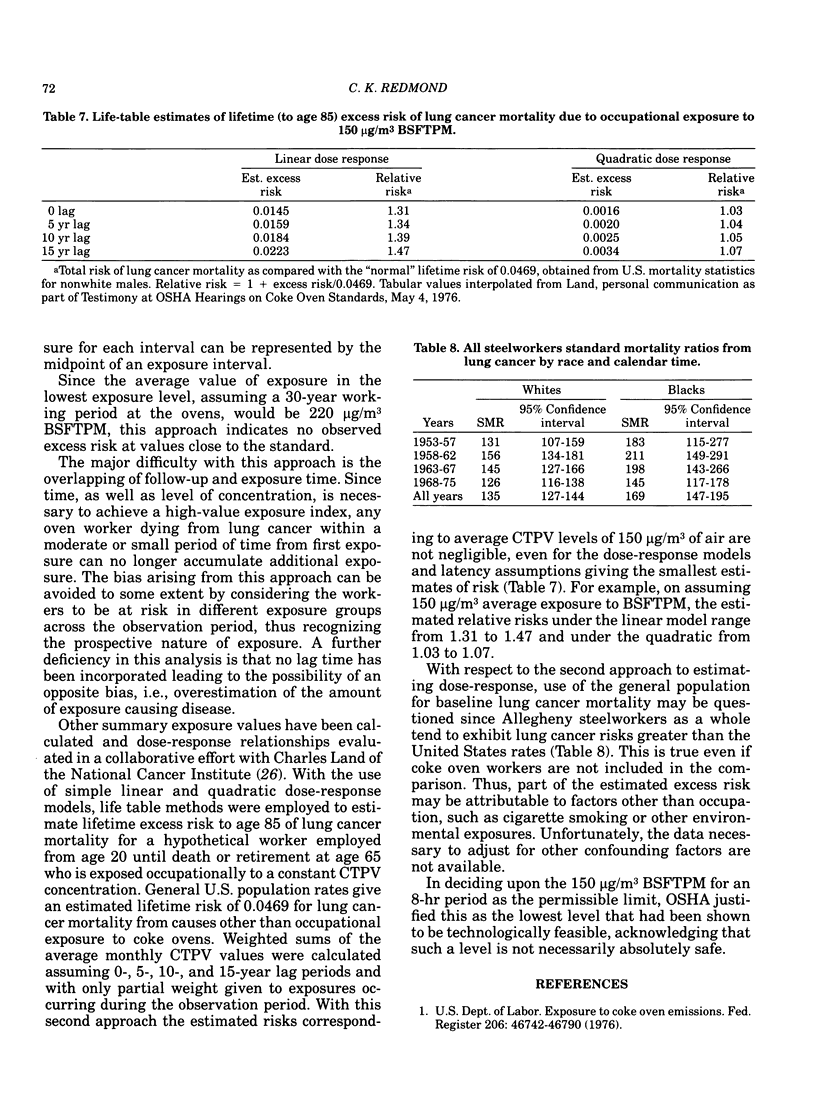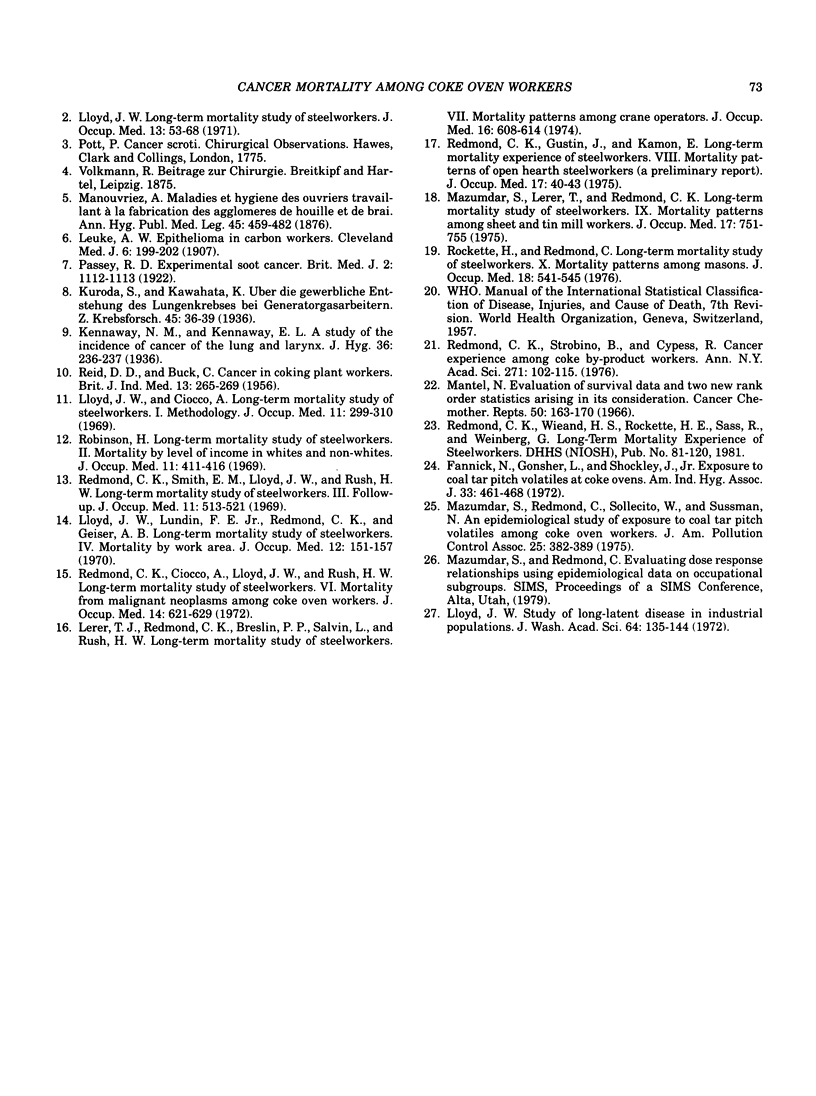Abstract
The OSHA standard for coke oven emissions, which went into effect in January 1977, sets a permissible exposure limit to coke oven emissions of 150 micrograms/m3 benzene-soluble fraction of total particulate matter (BSFTPM). Review of the epidemiologic evidence for the standard indicates an excess relative risk for lung cancer as high as 16-fold in topside coke oven workers with 15 years of exposure or more. There is also evidence for a consistent dose-response relationship in lung cancer mortality when duration and location of employment at the coke ovens are considered. Dose-response models fitted to these same data indicate that, while excess risks may still occur under the OSHA standard, the predicted levels of increased relative risk would be about 30-50% if a linear dose-response model is assumed and 3-7% if a quadratic model is assumed. Lung cancer mortality data for other steelworkers suggest the predicted excess risk has probably been somewhat overestimated, but lack of information on important confounding factors limits further dose-response analysis.
Full text
PDF






Selected References
These references are in PubMed. This may not be the complete list of references from this article.
- BUCK C., REID D. D. Cancer in coking plant workers. Br J Ind Med. 1956 Oct;13(4):265–269. doi: 10.1136/oem.13.4.265. [DOI] [PMC free article] [PubMed] [Google Scholar]
- Fannick N., Gonshor L. T., Shockley J., Jr Exposure to coal tar pitch volatiles at coke ovens. Am Ind Hyg Assoc J. 1972 Jul;33(7):461–468. doi: 10.1080/0002889728506687. [DOI] [PubMed] [Google Scholar]
- Lerer T. J., Redmond C. K., Breslin P. P., Salvin L., Rush H. W. Long-term mortality study of stellworkers. VII. Mortality patterns among crane operators. J Occup Med. 1974 Sep;16(9):608–614. [PubMed] [Google Scholar]
- Lloyd J. W., Ciocco A. Long-term mortality study of steelworkers. I. Methodology. J Occup Med. 1969 Jun;11(6):299–310. doi: 10.1097/00043764-196906000-00001. [DOI] [PubMed] [Google Scholar]
- Lloyd J. W. Long-term mortality study of steelworkers. V. Respiratory cancer in coke plant workers. J Occup Med. 1971 Feb;13(2):53–68. [PubMed] [Google Scholar]
- Lloyd J. W., Lundin F. E., Jr, Redmond C. K., Geiser P. B. Long-term mortality study of steelworkers. IV. Mortality by work area. J Occup Med. 1970 May;12(5):151–157. [PubMed] [Google Scholar]
- Mantel N. Evaluation of survival data and two new rank order statistics arising in its consideration. Cancer Chemother Rep. 1966 Mar;50(3):163–170. [PubMed] [Google Scholar]
- Mazumdar S., Lerer T., Redmond C. K. Long-term mortality study of steelworkers. IX. Mortality patterns among sheet and tin mill workers. J Occup Med. 1975 Dec;17(12):751–755. [PubMed] [Google Scholar]
- Redmond C. K., Ciocco A., Lloyd J. W., Rush H. W. Long-term mortality study of steelworkers. VI. Mortality from malignant neoplasms among coke oven workers. J Occup Med. 1972 Aug;14(8):621–629. [PubMed] [Google Scholar]
- Redmond C. K., Gustin J., Kamon E. Long-term mortality experience of steelworkers. VIII. Mortality patterns of open hearth steelworkers (a preliminary report). J Occup Med. 1975 Jan;17(1):40–43. [PubMed] [Google Scholar]
- Redmond C. K., Smith E. M., Lloyd J. W., Rush H. W. Long-term mortality study of steelworkers. 3. Follow-up. J Occup Med. 1969 Oct;11(10):513–521. [PubMed] [Google Scholar]
- Redmond C. K., Strobino B. R., Cypess R. H. Cancer experience among coke by-product workers. Ann N Y Acad Sci. 1976;271:102–115. doi: 10.1111/j.1749-6632.1976.tb23099.x. [DOI] [PubMed] [Google Scholar]
- Robinson H. Long-term mortality study of steelworkers. II. Mortality by level of income in whites and non-whites. J Occup Med. 1969 Aug;11(8):411–416. [PubMed] [Google Scholar]


